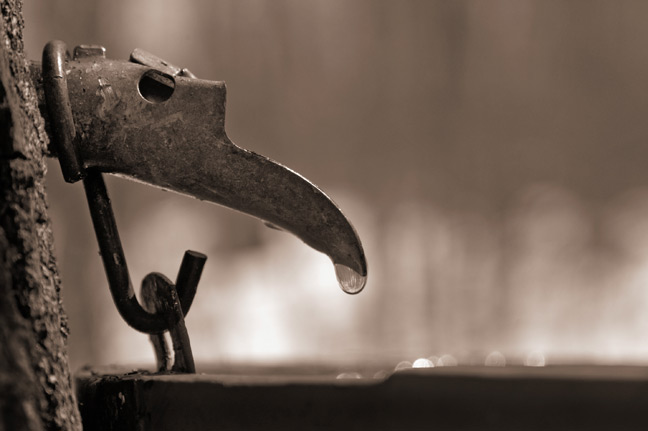UVM Proctor Page
Recent trends in the maple industry III - changes in sap yield
By TIMOTHY D. PERKINS, M.L. ISSELHARDT AND A.K. VAN DEN BERG |
This series of articles has described the changes in the U.S. maple industry over the past 15-20 years. We have witnessed an era of tremendous growth in production, much of it coming about due to the addition of taps. Utilizing the data collected by the U.S.D.A. National Agricultural Statistics Service, it is easy to see that one of the more striking changes though has been the increases in the quantity of sap per tap (sap yield) that producers are now able to collect.
Since 2001, despite annual fluctuations, maple syrup yields (gal syrup collected per tap) have generally increased strongly in all the states where data is available (Figure 1). These increases are not equal in all locations, but the linear trend lines of these data are all positive, with slopes ranging from a low of 0.003 (meaning the average increase in yield is 0.003 gal syrup/year over the period of 2001-2015) in Massachusetts to a high of 0.010 gal/year in Vermont. The same positive trend is observed in the Province of Quebec which experienced an increase of 0.004 gal/year in syrup yield over the same time period.
Converting these annual trends in yield (gal syrup/tap) to % increases in yield is also illuminating (Figure 2). If we use the average U.S. production from 2001-2005 of 0.190 gal/tap as a baseline, we find that the U.S. overall has experienced an approximate 4.2% increase annually in syrup yield through 2015 (calculated from the slopes of the linear trends). These increases however, are not equal across all locations. Massachusetts, Connecticut, Michigan and New Hampshire experienced the lowest rate of increase, with New York, Pennsylvania and Maine being intermediate, and Wisconsin, Ohio and Vermont increasing the fastest. Quebec yield increases fell between the low and intermediate groups of U.S. states. Overall, if this trend continues for the next few years, the increase in syrup yield will have doubled what was achievable only twenty years ago.
So what is driving these increases in syrup yield? There are several possible influences involved, and many of them are related and interconnected, so totally separating the effects is not possible in this analysis. The four key factors affecting syrup yield from maple trees: vacuum, taphole/spout/tubing sanitation practices, tree sustainability factors and climate (weather) are discussed below.
First, there have been many significant improvements in equipment and techniques over the past 15 years. Small (5/16”, 19/64”, ¼”) spouts that produce as well as older (7/16”) spouts were the first technological improvement. These allowed for nearly the same level of production but with far lower levels of internal compartmentalization, thereby reducing the possibility of tapping into stained, nonconductive wood, and improving tapping sustainability. The introduction of polyethylene tubing, which resists sagging and stretching far better than the older PVC-based tubing formulations has also had a positive effect on yields. Better tubing along with improved fittings meant better tubing installations in the woods, and more time spent correcting leaks than correcting other tubing issues. Inexpensive, annually-replaced spouts, often made of polycarbonate material which sticks better in the tree, along with CV spouts and adapters and guidelines for more frequent replacement of droplines have vastly improved sanitation at the taphole, and increased yields greatly. The use of improved pumps that are capable of producing high vacuum while remaining on all season has had a positive impact on yields. Dual-mainline installations help transfer higher vacuum levels at the tree, thus augmenting sap flow. Improved leak detection methods and procedures have also lead to increased production. These improvements have been driven by innovation and competition among the maple equipment manufacturers and dealers to provide high quality products, by cutting-edge research by maple scientists, and by strong outreach and education programs by Extension personnel and maple producer associations.
The addition of millions of new taps has also driven yields higher. New tubing and previously untapped trees will always outperform older tubing and trees that have been tapped for decades, but many of these new installations have also utilized the newest approaches to sap collection. Many of the newest systems when managed appropriately can yield over 0.5 gal of syrup per tap each year. The 12 year average at the University of Vermont Proctor Maple Research Center (Underhill Center, VT) from 2004 to 2015 is 0.59 gal/tap, with a high of 0.73 gal/tap (2004) and a low of 0.46 gal/tap (2012). Our minimum expectation each year is 0.50 gal/tap. Anything below that is considered a “poor” season. Of the past 12 seasons, only 2012 with the record high temperatures that occurred in mid-March (normally our peak production time) fell into that category.
The increasing trend towards larger operations is also associated with higher syrup yields. If we discount hobby producers (99 taps and under), there is a very strong positive relationship (r² = 0.81) between the number of taps and syrup yields, with producers over 3,000 taps producing nearly double the amount of syrup per tap than producers under 2,000 taps. This is likely due to the fact that producers with a large number of taps typically will use newer installations and high vacuum to increase sap production. Until recently, the high entry cost of good vacuum was an impediment to high syrup yields from small producers. With the recent introduction of low cost vacuum pumps, and with increasing use of 3/16” tubing on sloped sites producing high vacuum at a low cost, we expect that this gap in yields may become increasingly small over time. Higher syrup prices have also meant that moderate-sized producers were able to buy into at least an entry level of vacuum and still make a profit from their operations.
In summary, production in terms of maple syrup yields has risen greatly over the past one and a half decades. Barring any significant structural change in the industry, is likely that this trend will continue as producers continue to add taps and install or upgrade to higher levels of technology. What happens after the next few years is difficult to predict, however with the new technological advances being introduced, still in testing, and on the drawing board, it is likely that the trend will continue upward as long as prices remain stable or move higher. On that note, our next installment in this series will examine the changes in syrup prices over the past twenty years, and discuss what factors have been important in the changes we have seen.
October 2015


































